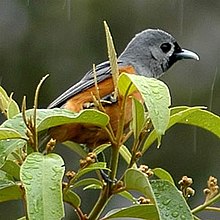Mask monarch
| Mask monarch | ||||||||||||
|---|---|---|---|---|---|---|---|---|---|---|---|---|

Mask monarch |
||||||||||||
| Systematics | ||||||||||||
|
||||||||||||
| Scientific name | ||||||||||||
| Monarcha melanopsis | ||||||||||||
| ( Vieillot , 1818) |
The mask Monarch ( Monarcha melanopsis ) is a bird art from the family of the monarch (Monarchidae). It occurs in Australia and New Guinea.
The IUCN classifies the stock situation of this type as ![]() (= least concern - not endangered). No subspecies are distinguished.
(= least concern - not endangered). No subspecies are distinguished.
features
Build and color
The mask monarch reaches a body length of around 16 to 17'9.5 cm, of which 6.9 to 8.1 cm is accounted for by the tail. The beak is 19.7 to 28.8 mm long. The mask monarch has a wing length of 82.5 - 98.5 mm and an average wingspan of 22.5 centimeters. The weight is between 19 and 27 g. There is no gender dimorphism .
Adult birds
The forehead, front parting, reins, chin and throat are black and form a striking black face mask. The rest of the head and the neck are blue-gray, while the ear-covers and the sides of the neck are pale silvery gray. In front of the eye there is a narrow white half ring that surrounds a narrow black orbital ring. The folded wings are blue-gray, the hand wings have dark brown tips. The rest of the top of the body is blue-gray.
The front breast is pale blue-gray, the rest of the underside of the body is intense orange-brown. The tail plumage is brownish gray on the underside. The beak is slate blue with a small white tip. The iris is black-brown, the feet are blue-gray.
Fledglings
Young birds lack the black face mask of adult birds. Their foreheads are pale orange-brown and then merge with the blue-gray of their heads. The rest of the upper plumage is a little more brownish than that of the adult birds. The chin and throat are gray-white with a light orange-brown tint. The breast is pale gray and also washed over with a light orange-brown. The rest of the underside of the body is slightly paler than that of the adult birds.
Distribution area and habitat
The masked monarch is a breeding bird in eastern Australia, which can be found in the winter months from the eastern half of New Guinea to the Louisiade archipelago . In Western Australia, New Zealand and the Aru Islands he is a rare stray visitor. In Australia it breeds from the tropical Atherton Tablelands to Lakes Entrance , a fishing port in eastern Gippsland in the Australian state of Victoria .
The masked monarch is primarily an inhabitant of rainforests. It occurs in tropical rainforests as well as monsoon rainforests and moist hardwood forests.
It is a distinctive migratory bird that stays in its breeding areas in eastern Australia from September to February / April, and then moves to its wintering areas. It can be observed in New Guinea from April to August. Ringing data show that they will return to their original breeding areas after the migration.
food
The masked monarch is an insect eater that finds its food mainly in tree tops and undergrowth. He very rarely gets to the ground. It mainly catches its food in flight. It only very rarely picks insects from leaves and branches.
Reproduction
The masked monarch breeds from October to February. It usually nests in thickly leafy or densely overgrown trees with climbing plants. The nesting trees are often close to water or in ravines. The nest is built between 1.5 and 10.7 meters above the ground. It is pear-shaped or conical in shape. It is usually built with needles from casuarines and cobwebs. The nest bowl is thickly lined with moss and lichen, parts of colored leaves or very small roots.
The clutch usually consists of two to three eggs. Both parent birds breed, the breeding season is around 13 days. It has not yet been investigated exactly when the nestlings fledge on average. The nestling period is definitely less than 21 days. The young birds that have flown out are fed by the parent birds for at least 4 days.
Life expectancy
A masked monarch ringed as an adult bird in New South Wales was recaptured 5 years later at the original ringing location.
literature
- PJ Higgins, JM Peter and SJ Cowling: Handbook of Australian, New Zealand & Antarctic Birds: Volume 7 Boatbill to Starlings, Part A: Boatbill to Larks . Oxford University Press, Melbourne 2006, ISBN 978-0-195-55884-5 .
Web links
Individual evidence
- ↑ Handbook of the Birds of the World zu Maskenmonarch , accessed on May 20, 2017
- ^ Higgins, Peter & Cowling: Handbook of Australian, New Zealand & Antarctic Birds: Volume 7 Boatbill to Starlings, Part A: Boatbill to Larks . P. 42.
- ^ Higgins, Peter & Cowling: Handbook of Australian, New Zealand & Antarctic Birds: Volume 7 Boatbill to Starlings, Part A: Boatbill to Larks . P. 49.
- ^ A b Higgins, Peter & Cowling: Handbook of Australian, New Zealand & Antarctic Birds: Volume 7 Boatbill to Starlings, Part A: Boatbill to Larks . P. 43.
- ^ A b Higgins, Peter & Cowling: Handbook of Australian, New Zealand & Antarctic Birds: Volume 7 Boatbill to Starlings, Part A: Boatbill to Larks . P. 44.
- ↑ a b c Higgins, Peter & Cowling: Handbook of Australian, New Zealand & Antarctic Birds: Volume 7 Boatbill to Starlings, Part A: Boatbill to Larks . P. 45.
- ^ Higgins, Peter & Cowling: Handbook of Australian, New Zealand & Antarctic Birds: Volume 7 Boatbill to Starlings, Part A: Boatbill to Larks . P. 46.
- ^ Higgins, Peter & Cowling: Handbook of Australian, New Zealand & Antarctic Birds: Volume 7 Boatbill to Starlings, Part A: Boatbill to Larks . P. 47.

